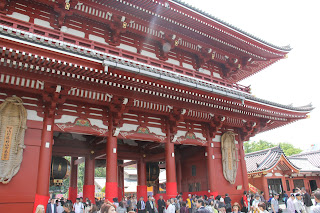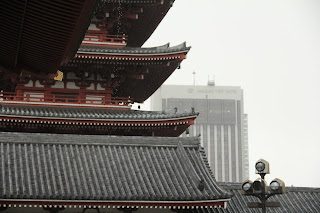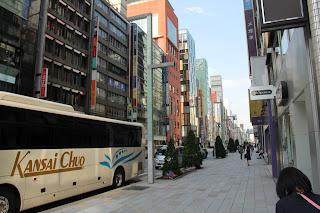The easiest way to identify a Shinto shrine is a Torii gate, shown here in this picture.

The stone structure is in place to divide our world and the spiritual world. Though Buddhism and Shinto are closely related, a Torii is only placed at the entrance of a Shinto shrine, making it is easiest way to identify if you're at a temple or a shrine. This particular location, the Asakusa shrine, was built in 1649 to commemorate the three men who built the adjacent Buddhist Sensō-ji temple and their enshrinement as Shinto gods.

The placement of this photo may suggest that this guy is one of the three men the shrine is dedicated to, but that would be silly if they were still alive in the physical world. However, I'm sure this is the same style of clothing worn by the men.

Approaching the Sensō-ji, you pass through the Nakamise shopping street. This 800-foot long street is made up of 89 shops that provide small snacks and locally made Japanese souvenirs. One random toy shop had 7 of the original X-Men toys from 1992 still sealed in their original packaging. I would have cleaned this guy out had I brought a larger suitcase, and if he spoke English I would have told him how much money he could make posting these bad boys to eBay. After a 15 second contemplation, I decided to carry on leaving them to be discovered by some other traveler. These shops have been there for a couple hundred years and have needed to be rebuilt twice: Once after the 1923 Great Kantō earthquake, and the other after the air raids of WWII.



Sensō-ji is Tokyo's oldest temple. Built in 645 by two brothers who found a statue of Bodhisattva Kannon (Goddess of Mercy) while fishing in the nearby Sumida River. Legend says that even though they returned the statue to the river, she would always make her way back to them. The leader of the village recognized the sanctity of the statue and donated his own home to be remodeled into a temple to house Kannon. I read this background before arriving to the temple and I was absolutely blown away by the architecture and how well it had been preserved. Then, like a child learning the truth about Santa Claus, I learned the original temple was almost completely destroyed by the air raids of 1945 (Asakusa Shrine survived it). What stands today, is the rebuilt site commissioned by the Japanese government after WWII to symbolize the nation's rebirth.








At first glance, these Swastikas would appear a bit puzzling given their most recent use was by the Nazis. Actually, Hitler adopted the Swastika from Eastern civilizations and is a symbol of balance and well-being. Unlike the right-facing Swasies Hitler used, this left-facing one is called a Manji in Japan and is used to mark a Buddhist temple.
Pagodas, five-story structures with multiple eaves, are also seen in many Eastern civilizations are mark a location of a place of worship. Unfortunately, this one was also destroyed in the war and later rebuilt.


Unfortunately, the festival I was there to see was either on at a different time during the three-day weekend or delayed due to the stormy weather. All I saw were the prepared Mikoshis, the heavily decorated portable shrines used to transport a Shinto deity, that devotees would walk through the street on their shoulders during the festivities. For a half hour the rain came down really hard, requiring the crowds to retreat underneath the Hozomon gate.


















